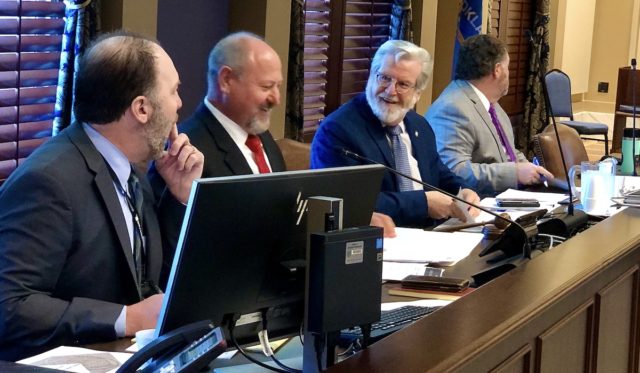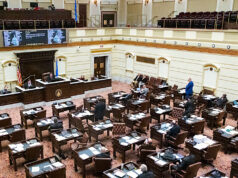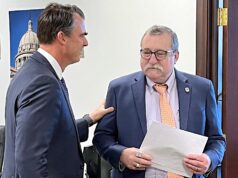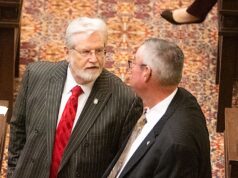

An effort to map Oklahoma’s broadband network and a project to renovate the emergency department at Oklahoma Children’s Hospital to add 10 pediatric behavioral health beds are set to become the first two recipients of the state’s allotment of American Rescue Plan Act money.
The Legislature’s Joint Committee on Pandemic Relief Funding voted unanimously to dedicate more than $2 million for the broadband mapping project and $7.5 million for the hospital project, but the committee still has more than $1.8 billion to allocate in the coming months.
“The Legislature has indicated that they want these funds to be strategically invested to be transformational for our state,” Melissa Houston, the committee’s contracted consultant, told lawmakers Monday. “We’ve have over $7 billion in requests for $1.8 billion in funding.”
During Monday’s committee meeting, both Republicans and Democrats asked questions about the speed and scope of allocating ARPA money. Senate Appropriations and Budget Chairman Roger Thompson (R-Okemah) told members that Houston’s organization reviews applications for compliance and then directs the applications to the committee’s working groups, which then send recommendations to the full committee for consideration.
Rep. Mike Osburn (R-Edmond) asked Thompson whether lawmakers could review the comprehensive list of applications. Thompson said legislators could come to his office to look over the slate of proposals.
“It’s not made public, we don’t want it out in the public,” Thompson said. “These are some private requests that have come in.”
Details about the two projects
Thompson and Rep. Logan Phillips (R-Mounds) told the committee that the Oklahoma Department of Commerce will receive the $2 million dedicated for broadband mapping and will execute the operation after purchasing software and data sets.
“Before we can do anything with broadband across the state, we have to know where it’s needed. The mapping is very, very needed,” Thompson said after the meeting. “We’ve got many partners already working across the state. The rural electric co-ops are doing fabulous work in putting out broadband. We want to make sure we’re working with them.”
For the Oklahoma Children’s Hospital pediatric behavioral health project, the details are a little more complicated. Monday’s allocation of $7.5 million will fund renovations of the emergency department and the establishment of 10 dedicated beds for youth experiencing mental health crises.
The entire hospital project — housed under the new OU Health umbrella organization — will cost about $115.8 million, 51 percent of which has already been identified from state, trust and private sources. Once the remaining $59 million is identified — $7.5 million of which the committee allocated Monday — the project will eventually create more than 70 pediatric behavioral health beds.
In presenting the $7.5 million funding proposal, Sen. John Haste (R-Broken Arrow) ran through a litany of statistics indicating that the enormous need for pediatric mental health services has only grown during the pandemic.
“Suicidal teens are seen every shift,” Haste said during Monday’s hearing, noting that the full project could be completed as early as March 2023. “This is something that can move, move quickly and will have an immediate effect on the citizens of Oklahoma.”
But Sen. Adam Pugh (R-Edmond) asked whether Monday’s vote to allocate $7.5 million was functionally a vote to cover the rest of the project’s costs as well because “we’re not going to vote on $7.5 million and then not fund the rest.”
“We are specifically addressing the $7.5 million of this project. We will separately consider the balance of the project, which is $48.9 million, or something like that,” Haste said. “Specifically today, we are dealing with just the $7.5 million. Will we agree to fund the other? Obviously that’s very possible.”
House Appropriations and Budget Committee Vice Chairman Kyle Hilbert (R-Depew) said the joint committee on ARPA funds “could fund the $7.5 million and not fund the rest,” but he noted the operational support provided in the Legislature’s most recent state budget passed in May.
“This spring, the House and Senate both approved $9.9 million in state appropriations toward this project,” Hilbert said. “And the messaging out of both the House and Senate is that this is a project we would like to more fully fund out of ARPA.”
Pugh asked whether the behavioral health project will result in “up-staffing” for which the Legislature will have future obligations. Hilbert said the renovated emergency department will add 30 full-time employees, but that the project is expected to be self-sustaining once operational. He said the full project would eventually add more than 200 full-time employees.
After the meeting, Thompson said the pediatric behavioral health expansion is an important project for Oklahoma families.
“We’re sending our most critical behavioral health children out of state. We’re better people than that,” Thompson said. “I looked at the children’s behavioral health centers at Columbus and Cincinnati and said ‘we need something like that in Oklahoma.’ OU’s helping us fulfill that. This is being driven because we need mental health for our children in the state.
Follow @NonDocMedia on:
‘A little bit of a pucker factor’
How the joint committee decides to spend its remaining $1.8 billion remains to be seen.
“Are we going to move forward hearing the projects one at a time and then voting on the projects one at a time until we zero-out our funds?” Senate Minority Leader Kay Floyd (D-OKC) asked Thompson.
The Senate appropriations chairman responded that projects are being reviewed by working groups after going through the state’s ARPA application portal process.
Pugh noted that more than 470 projects have been submitted through the portal already.
“We’ve gone through two,” Pugh said. “That gives me a little bit of a pucker factor as we end the year.”
Hilbert said the joint committee’s working group on health care workforce issues has requested all related applications to be submitted by Jan. 3 so lawmakers can review them prior to the start of regular session Feb. 7.
After the meeting, Thompson described the committee’s plans moving forward.
“We’ll continue to vet ideas [and] we’ll get down to the working groups and let the working groups send it back to this committee and send it on to the steering committee to move forward to the governor to sign,” Thompson said.
Money for municipal water, wastewater systems
During Monday’s meeting, committee members also received a brief update from Oklahoma Municipal League director Mike Fina regarding Oklahoma’s 579 “non-entitlement units,” or NEUs, that are eligible to seek money from “two tranches” of ARPA funds. NEUs are small towns and communities around the state.
Fina said the first tranche of funding totals $119 million, and that so far 341 NEUs have signed up and accepted funds.
“It’s going to be overwhelmingly water and wastewater,” Fina said.
He said the management of those dollars is expected to flow through a state agency, such as the Oklahoma Water Resources Board.
Background on ARPA funding
ARPA provided federal funding to state, local and tribal governments to assist them in responding to the impacts of the pandemic, such as providing premium pay for essential workers, replacing revenue lost due to the pandemic, making investments in water, sewer and broadband infrastructure and and responding to the public health and economic emergency.
Oklahoma received a total of $3.19 billion in ARPA funding with $1.87 billion earmarked for state investment and $1.32 billion available to counties, cities and local communities. Funds must be allocated by December 2024 and used by December 2026. The stated goals of the Legislature’s joint committee are to:
- Build a stronger, more innovative and more diverse Oklahoma economy;
- Enhance capabilities of state services for the wellbeing of all citizens, especially the most vulnerable and;
- Invest in physical and digital infrastructure to expand economic growth.




















